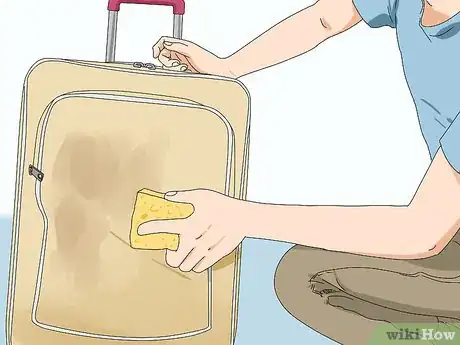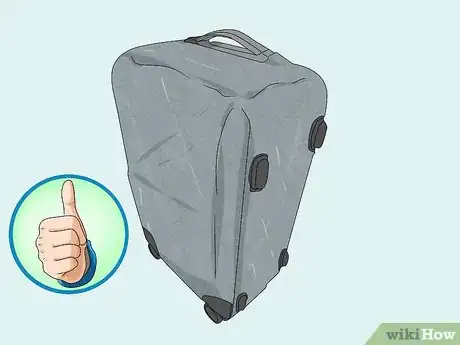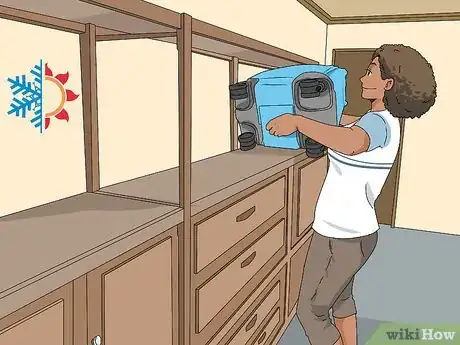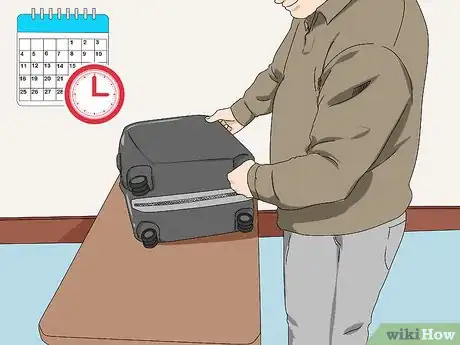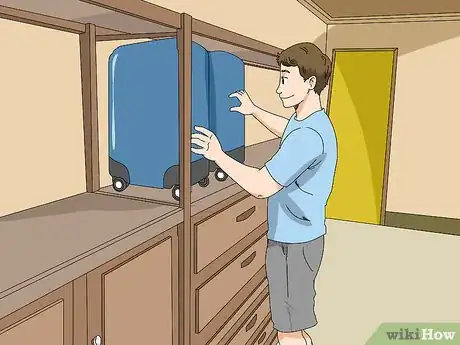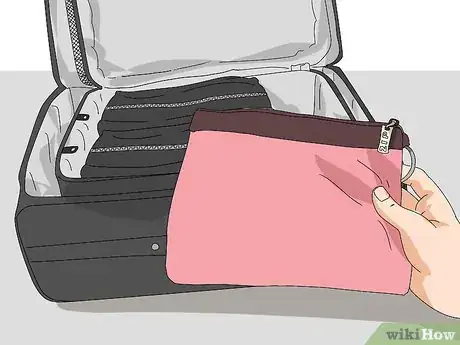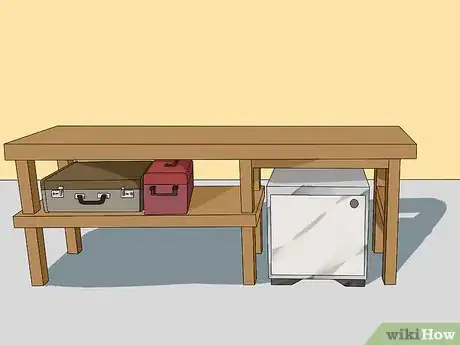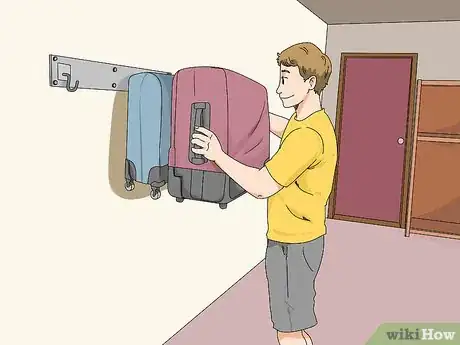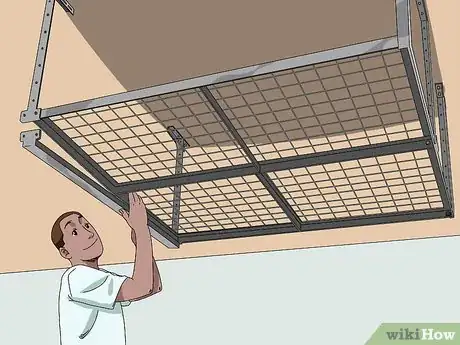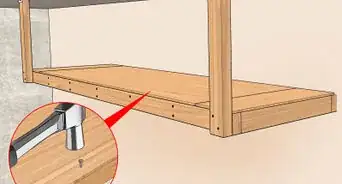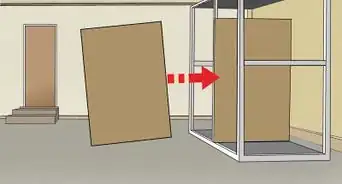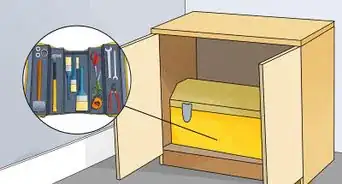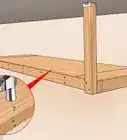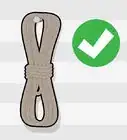This article was co-authored by Julie Naylon. Julie Naylon is the Founder of No Wire Hangers, a professional organizing service based out of Los Angeles, California. No Wire Hangers provides residential and office organizing and consulting services. Julie's work has been featured in Daily Candy, Marie Claire, and Architectural Digest, and she has appeared on The Conan O’Brien Show. In 2009 at The Los Angeles Organizing Awards she was honored with “The Most Eco-Friendly Organizer”.
There are 7 references cited in this article, which can be found at the bottom of the page.
This article has been viewed 36,451 times.
It can be hard to find room for your bulky luggage when you’re not using it. Luckily, that’s just the kind of problem garages can help solve. Take advantage of the shelves you already have in your garage by using them to store suitcases and travel bags that you don't have room for inside your home. If that doesn’t get it all squared away, consider mounting a set of racks and hooks to create a little extra space or using your luggage itself to store other small items.
Steps
Protecting Your Luggage
-
1Clean your luggage before putting it away. Take a moment to brush off any loose dust and debris by hand. Use a damp cloth or sponge to wipe down pieces in need of more intensive cleaning, including those with stains or residue. A quick cleaning will help reduce the amount of dirt your bags collect while in storage.
- After using water to clean a piece of luggage, leave it out to air dry thoroughly before putting it back in a confined space.
-
2Use luggage covers to keep your bags in good condition. A couple of cheap luggage covers will safeguard your bags from dirt, humidity, and sun damage. These can be slid on and off quickly for easy protection, and are sold at most airports and luggage stores for just a few dollars.[1]
- If you don’t feel like spending money on luggage covers, you can also make your DIY version by loosely draping a drop cloth or piece of plastic sheeting over your bags where they sit.
- Avoid keeping your luggage covered too tightly, or for longer than a couple of months at a time. Doing so could trap moisture inside, inviting mold to set up in spite of the extra layer.[2]
Advertisement -
3Pick out a cool, dry spot to store your luggage. Keep your bags away from dark, dank corners, standing water, or direct sunlight. An environment with a consistent temperature and a little airflow (whether from an open garage door or portable fan) will generally be the best option for long-term storage.[3]
- Prolonged exposure to moisture could leave your luggage vulnerable to mold and mildew or ruin the texture of leather bags.
- Similarly, the sun’s rays can bleach dark materials, causing them to fade over time.
-
4Check your bags periodically for mold or damage. Get in the habit of taking your bags out of storage about once a month to see what kind of shape they're in. Look closely for dirt, dust, mildew, and insects, as well as evidence of physical deterioration. If necessary, clean soiled bags using a cloth or sponge dampened with soapy water.[4]
- If you have no choice but to keep your bags in a humid garage, bring them inside your home or leave them in an open area to air out every couple of weeks.
- Considered treating leather items with an aerosolized anti-mold spray. These products contain mild chemicals that smother the bacteria and fungal organisms responsible for the growth of mold and mildew.[5]
Finding Room for Your Luggage
-
1Arrange your bags so that they take up as little space as possible. Don’t just pile your bags on top of one another or line them up end-to-end. Make the most of your square footage by standing suitcases up vertically or resting them on their sides, and situating mismatched bags in rows of equal length.
- Once the big stuff is out of the way, use small and irregularly-shaped pieces to fill in the gaps. Imagine that you’re joining puzzle pieces together.
- A few inches can make the difference between everything fitting together perfectly and being forced to make a trip to the attic.
EXPERT TIPIf you travel often, put the suitcase you use most often where it will be the easiest to reach.
Julie Naylon is the Founder of No Wire Hangers, a professional organizing service based out of Los Angeles, California. No Wire Hangers provides residential and office organizing and consulting services. Julie's work has been featured in Daily Candy, Marie Claire, and Architectural Digest, and she has appeared on The Conan O’Brien Show. In 2009 at The Los Angeles Organizing Awards she was honored with “The Most Eco-Friendly Organizer”.
Julie Naylon
Professional Organizer Julie Naylon
Julie Naylon
Professional Organizer -
2Store small bags inside bigger ones to save space. Rather than trying to find a separate spot for each piece of luggage, consolidate them together—close up a compact suitcase inside a larger trunk, or slip an overnight bag or satchel into a full-sized duffel. That way, you’ll end up with fewer pieces to put away.
- Avoid folding, bunching, or rolling bags made from delicate materials, as this could tear them or result in permanent creasing.
- If storage space is at a premium in your garage, it might be a good idea to purchase a collapsible suitcase. Bags made from flexible, durable fabrics like canvas and nylon will also be easier to cram inside other bags.[6]
-
3Convert your luggage into extra storage if your garage is full. When you’re struggling to find a place to leave your bags, it’s easy to forget that they were designed to hold things themselves. Put them to work by filling them with whatever tools and accessories you happen to have laying around. You can then keep them right there on the shelf or workbench where your toolbox used to be.[7]
- Don’t use your luggage to store chemicals, oils, nails, tacks, or any other substances that may end up being spilled inside.
- When it's time to take a trip, empty the luggage you've been using for storage and group the items inside on the shelf or rack where the bags sat.
-
4Utilize the shelf space you have available. Most homeowners have at least 1 or 2 shelves in their garages already. These can come in handy for putting away smaller bags like carry-ons, or even mid-size suitcases. A few feet of shelf space may be all you need if you tend to travel light.
- If you don’t have shelves in your garage, you may be able to put in a basic unit for as little as $100.[8]
-
5Stash leftover suitcases under a table or workbench. If you have a high-topped workbench in your garage, the open area underneath may be just the place to deposit your unused luggage. Be sure to stack your bags neatly to keep them from tumbling out or hiding important tools and equipment from view.
- Consider adding a small shelf to the lower part of your table or workbench if it doesn’t have one already built-in.
- You could also try sliding slimmer bags behind an unattached table if there’s enough clearance.
-
6Hang lightweight pieces from hooks. Slide items with straps or handles, like backpacks and shoulder bags, onto wall-mounted hooks or pegs. One of the biggest advantages of hanging your luggage is that it’s usually possible to fit more than 1 piece on the same hook, which means a single spot could hold as many as 2-3 bags.
- Make sure your bags are hanging low enough for you to retrieve them without a hassle.
- Wall-mounted hooks and all the hardware needed to install them can be bought for as little as $4-5 apiece at most hardware stores.
-
7Invest in a set of ceiling-mounted racks if you don't have floor or shelf space. Mountable racks bolt to the ceiling, creating a useful storage nook where there was nothing but space before. Once they’re in place, simply stow your trunks, suitcases, bags, and carrying cases overhead until the next time you need them.[9]
- You can buy ready-to-assemble ceiling-mounted storage racks online, or at most home improvement stores.
- Be sure to position the rack in such a way that it doesn't prevent your garage door from raising or lowering properly.
- Mountable racks can only support so much weight. To avoid damaging the ceiling in your garage, make sure you only store your luggage empty.
Expert Q&A
Did you know you can get expert answers for this article?
Unlock expert answers by supporting wikiHow
-
QuestionHow do I store my bags?
 Julie NaylonJulie Naylon is the Founder of No Wire Hangers, a professional organizing service based out of Los Angeles, California. No Wire Hangers provides residential and office organizing and consulting services. Julie's work has been featured in Daily Candy, Marie Claire, and Architectural Digest, and she has appeared on The Conan O’Brien Show. In 2009 at The Los Angeles Organizing Awards she was honored with “The Most Eco-Friendly Organizer”.
Julie NaylonJulie Naylon is the Founder of No Wire Hangers, a professional organizing service based out of Los Angeles, California. No Wire Hangers provides residential and office organizing and consulting services. Julie's work has been featured in Daily Candy, Marie Claire, and Architectural Digest, and she has appeared on The Conan O’Brien Show. In 2009 at The Los Angeles Organizing Awards she was honored with “The Most Eco-Friendly Organizer”.
Professional Organizer
Things You'll Need
- Shelves
- Ceiling-mounted storage racks
- Mountable hooks or pegs
- Luggage covers
- Dropcloth or plastic sheeting
- Cloth or sponge (for cleaning)
References
- ↑ http://www.wisegeek.net/how-do-i-choose-the-best-luggage-cover.htm
- ↑ https://www.apartmenttherapy.com/suitcase-storage-168532
- ↑ https://herpackinglist.com/2013/08/how-to-clean-your-luggage/
- ↑ https://herpackinglist.com/2013/08/how-to-clean-your-luggage/
- ↑ https://extension2.missouri.edu/gh5928
- ↑ https://www.apartmenttherapy.com/suitcase-storage-168532
- ↑ https://www.apartmenttherapy.com/10-clever-ways-to-store-and-use-your-luggage-at-home-241591
- ↑ http://www.businessinsider.com/best-storage-shelves
- ↑ https://www.familyhandyman.com/garage/storage/products-to-maximize-your-garage-ceiling-storage/view-all/
